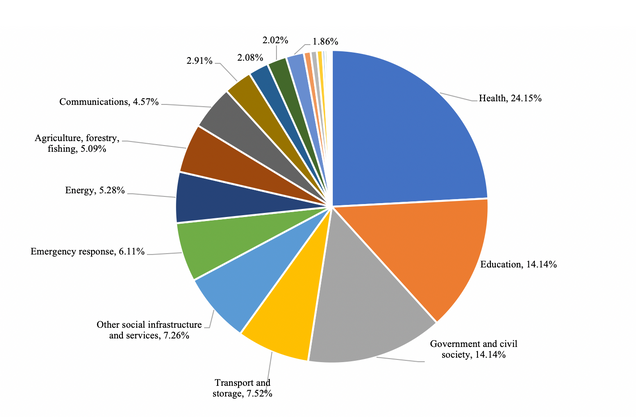Webinar Summary: Africa and China – Development Cooperation for Structural Transformation

By Yan Wang
After over 70 years of development since World War II, most emerging markets and developing countries still lag behind advanced industrial countries with large income gaps. In the 1950s-1970s, China was poorer than most African countries, but after 40 years of rapid growth, the per capita income of Chinese people is twice Africa’s average. However, China’s per capita income today, at a little over $10,000, is still one-fifth of incomes in advanced industrial countries.
Why is catching up economically so difficult?
A forthcoming paper by Justin Lin and myself attempts to approach this question through the lens of structural transformation. As part of the Fall 2021 Global China Research Colloquium, I presented our preliminary research findings.
What is structural transformation? It is a process of a country’s economic activities moving from the primary sector of resource extraction and agriculture, to manufacturing activities, and then to services. This process is critical for job creation and productivity growth, yet mainstream neoliberal economics has paid little attention to it.
The paper starts by looking at China’s experience in structural transformation, then moves on to review Africa’s achievements and challenges in structural transformation. Using the analytical framework of New Structural Economics (NSE), we attempt to first identify African countries’ bottlenecks for structural transformation, and then examine if China-financed, completed projects have addressed these bottlenecks.
As to China’s structural transformation, as late as 1984, 50 percent of China’s exports consisted of crude oil, coal and agricultural products. China was, as many African countries are, an exporter of primary products, but through reforms, openness and attracting foreign direct investment, China was able to shift to labor intensive exports using the Special Economic Zones (SEZs) and Original Equipment Manufacturer (OEM) model. After China joined the World Trade Organization in 2001, China became an exporter of high-tech and innovation-intensive products, transforming the country into a sophisticated manufacturing powerhouse.
Reviewing Africa’s structural transformation, we can see that many countries have experienced premature de-industrialization, in particular, countries like South Africa and Nigeria have seen the value add of manufacturing decline in recent years. Other countries have stagnated with little progress in developing their manufacturing sectors. Only in recent years has an uptick in manufacturing value added been seen in a few countries.
The New Structural Economics analytical framework was developed by Justin Yifu Lin when he was the Chief Economist at the World Bank. To jump start a poor country’s economy, he argued one should not focus on what the country does not have, but on what the country does have – i.e., its endowment and comparative advantage (CA). A country’s industrial structure is endogenous to its CA, and based on Adam Smith, the CA is based on the country’s endowment – the relative abundance of its human capital, natural capital and produced capital.
But in order for countries to export products, they must have electricity, roads and ports. Critically, many African countries do not have sufficient access to electricity and roads. In our research, we identified hard and soft infrastructure bottlenecks. Indicators for hard infrastructure include access to clean water, electricity, roads, railways, telecom and internet, while indicators for soft infrastructure include health, education, government effectiveness and the environment.
We then examined the Chinese financed and completed projects by sector using AidData Version 2.0, filtering out projects that were on-going, suspended or cancelled. This left 3,128 projects that were completed, “recommended for aggregates” and form a part of host countries’ public assets, such as electricity generation stations, power grids, hydropower stations, airports, roads, railways and ports, hospitals and schools. Figure 1 below shows the composition of these completed projects by sector, by project count.
Figure 1: China-Financed and Completed Projects in Africa

Did these Chinese financed projects address Africa’s bottlenecks? We found that 78 percent of the completed projects in hard infrastructure sectors matched with Africa’s bottlenecks in location and sector. In terms of soft infrastructure, 74 percent of the projects matched with Africa’s bottlenecks.
However, there is ample room for improvement. Of the completed projects, 22 percent to 26 percent have targeting issues, meaning that the projects may not have addressed the host country’s greatest needs.
As South-South development cooperation strengthens, the structural transformation of Africa has begun. Since 2011, there has been an uptick in manufacturing value added in GDP for 18 countries. Additionally, the Africa Continental-Wide Free Trade Area (AfCFTA) could integrate domestic markets and promote intra-regional trade, as Africa’s population rapidly increases, its middle-income groups expand, its purchasing power increases and governance improves. According to the NSE, establishing SEZs and attracting FDI, the relocation of manufacturing firms will bring technical know-how to Africa and can help enhance their export capacity. In particular, an EY study found that China’s outward FDI created more jobs than other source countries. Between 2014–2018, 137,028 jobs were created, much higher than those created through investment of countries such as the US, UK and France, among others.
In summary, China has helped address Africa’s bottlenecks in hard and soft infrastructure over the last 20 years. According to data from China’s Ministry of Foreign Affairs, “China has built for Africa over 6,000 kilometers of railways and the same mileage of roads, nearly 20 ports and over 80 large-scale power plants, and more than 130 medical facilities, 45 stadiums and 170 schools. These infrastructures have made a big difference in Africa’s economic and social development.” They also form the critical public assets of the African continent, the backbone of their productive and export structure.
However, there is ample room for better targeting with more investment in agriculture and green sectors. China must abide by environmental, social and governance rules and give special attention to health, education and governance. Recently, China committed to stop financing coal-fired power plants and to increase investment in renewables. Among the subset of 3,128 completed projects we examined, over 60 percent of China’s completed projects were in green sectors.
There are huge challenges in the post-COVID-19 era and China and African countries must re-think their ways of cooperation. We believe that China should strengthen support to multilateral development agencies, especially on debt restructuring. All partners should invest more in green sectors to combat climate change using equity investment and FDI in addition to concessional and commercial loans. To improve transparency and accountability, China needs to enact a foreign aid law, covering all instruments of overseas development finance: aid, trade (export credit) and public and private investment (concessional and commercial loans, bonds and equity). The current regulations on foreign aid are not comprehensive, nor sufficient.
By building on Africa’s strategic vision for the continent such as the Agenda 2063, and utilizing South-South development cooperation, all stakeholders can come together to support and sustain structural transformation, job creation and poverty reduction in Africa.